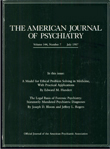Dysthymia and Comorbid Disorders
To the Editor: I read with great interest the serendipitously juxtaposed articles by Daniel N. Klein, Ph.D., et al. (1) and Ernst R. Berndt, Ph.D., et.al. (2). The article by Dr. Klein et al. described an elegantly performed 5-year study of the course and outcome of dysthymic disorder, whereas the article by Dr. Berndt et al. addressed the loss in personal achievement and actualization among patients with chronic depression. Clearly, the cost in human suffering and compromised development as a result of these mood disorders is profound and has heretofore been underappreciated.
From the details of the article by Dr. Klein et al., I was able to glean further differences between their cohort with dysthymic disorder and the group with major depression without dysthymic disorder that may be of significance and warrant further discussion and research. Table 1 shows three comorbid conditions that were present at significantly higher rates in the dysthymic disorder cohort. Dysthymic patients were more likely to have suffered from recurrent major depression (among the dysthymic disorder subjects with a history of discrete episodes of major depression), personality disorder, and substance abuse or dependence (1).
The poorer outcomes in the cohort of patients with dysthymic disorder than in the “pure” cohort of patients with major depression may initially appear to be a somewhat paradoxical finding in that dysthymic disorder seems to be a minor illness compared to major depression. Do the authors believe that the poorer clinical outcomes may relate in part to the comorbid psychiatric illnesses in the cohort with dysthymic disorder? It is common clinical experience to encounter patients with chronic mood symptoms for whom personality disorder or substance use disorder is the primary diagnosis. A study of dysthymic disorder versus major depression in which the study groups did not differ in the prevalence of these potentially complicating comorbid conditions could yield different results in terms of patient outcomes. The report by Dr. Klein et al. highlighted the vexing issue of psychiatric comorbidity in dysthymic disorder.
1. Klein DN, Schwartz JE, Rose S, Leader JB: Five-year course and outcome of dysthymic disorder: a prospective, naturalistic follow-up study. Am J Psychiatry 2000; 157:931–939Link, Google Scholar
2. Berndt ER, Koran LM, Finkelstein SN, Gelenberg AJ, Kornstein SG, Miller IM, Thase ME, Trapp GA, Keller MB: Lost human capital from early-onset chronic depression. Am J Psychiatry 2000; 157:940–947Link, Google Scholar



